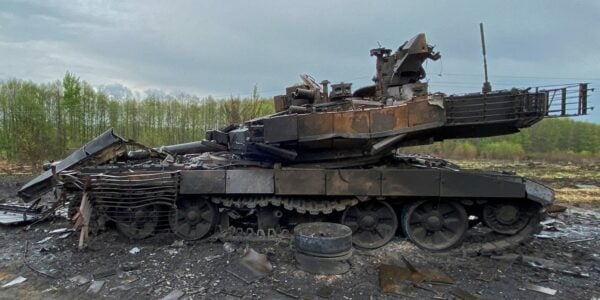
The Most Advanced Tank on either side of the Conflict to date, a Russian T-90M sits burnt out after it was destroyed fighting in Ukraine.
While there are a lot of conflicting reports on the front lines in Ukraine, it seems as if the need for added military support in Eastern Ukraine is needed now more than ever. The debate on sending European Leopard 2 tanks to Ukraine was finally met with a coordinated response to Ukraine by their Western Allies. British Challenger 2 tanks look to be the first to enter the region, followed by American Abrams tanks and a good number of Leopard 2 variants from many countries. With Ukraine now turning to an offensive posture in order to regain their territory, defence tactics will likely make the operations fairly costly, even with new and modern equipment.
Much of the eventual lead up to this conflict came from extremely poor and unplanned policy decisions by all actors. When Russia took over Crimea in 2014, the Western response to an ever growing threat in Syria and Northern Iraq was to vacate the theatre and allow Russia to become a major hegemonic power in the Middle East. Russian allies were emboldened by these measures, and now are in a better position to help Russia prolong the conflict in Ukraine. The abandonment of Afghanistan and Western Allies showed that being a friend to the United States and Europe would not ensure stability or assistance, even if you were on the right side of history in a conflict. Even after a year of brutal conflict in Ukraine, Russia and its supporting countries are able to prolong support and conflict against civilians in Ukraine without a sufficient response from the West.
There are little doubts that invading Ukraine for so little gain was not worth Russia’s economy, the lives of its youth, or future for its people. The image of strength and a consistent narrative in promoting this strength contributes a great deal to the ongoing support for this conflict. Western Allies must coordinate their actions to counter that strength. The reality is that this has only been done via support for the Ukrainian military in the field.
The displacement of Russian oil and gas should have been a priority for the Western Allies in sanctioning Russian military expansionism. While Germany and Europe are pushing away from Russian Energy, the reality of this conflict is that it truly began in 2014, and since then many EU states have welded their economies to Russian oil. What showed weakness in 2022 is the lack of North American energy support for their allies in NATO, that would have a greater effect in defunding Russia’s military than sending old shells and used equipment. Energy support for NATO and other allies is a strategic initiative, especially if it affects the citizen population. The lack of energy supports for Europe might contribute as much to Putin’s conflict as Iran or China. The optics of it alone will certainly prolong the conflict.
The waning support for Iran’s protesters allows for a myriad of security issues that lead to more Russian support in Ukraine. With a muted response to women in Afghanistan, the women of Iran likely chose this as one of their last moments to stand up as they saw Western support for their rights dwindling. With their protests now being put on the fifth page of Western papers, the increase in military activity coming from Iran’s regime while hurting their own citizens comes from a weak response to both actions. With drones in Ukraine and ships approaching Panama, balloons over Portland are quite far down the list of threats to international safety. The responses have become so impotent that a G7 leader has now taken the position of claiming their own intelligence agencies and vast majority of journalists are overtly lying when proven foreign interference in his Government is being revealed on a daily basis. You cannot fight against tyranny if you are an elected King who only acts towards their own best interests. Absolutist Corruption, Corrupts Absolutely.
Much of the weakness shown by Russia has come with video and spectacular images of modern Russian tanks and equipment being torn apart. Much of this has come at the end of very advanced, expensive, and limited number of anti-tank missiles provided at the early stages of the war in order to defend against a Russian invasion. With Ukraine now challenging entrenched areas, the same level of response will be met against Western tanks trying to take back territory in Eastern and South Eastern Ukraine. The image of Western tanks being torn apart on the battlefield by Cold War era anti-tank missiles might turn the narrative of a weak Russia in Western media towards one that turns the public increasingly against support for the war. The image of destroyed Leopard 2s will be contrasted against the images of knocked out T-90M tanks in the news. For those farther from the conflict, it might become a struggle for public support as no one knows how Americans will feel about seeing a burnt out Abrams on a 24 hour news cycle, even if the crew survived the encounter.
All tanks are vulnerable, with the newer ones designed to keep the crew alive after a strike on their vehicle. The value of the images however might do more to change the narrative than many of the other actions taken to physically challenge Russia in the field. Much of this conflict is built around power and the appearance of strength. A few pictures might do more than another round of sanctions in determining the outcome of the conflict. One thing is clear however, you cannot make your position weaker and expect a positive outcome in 2023.